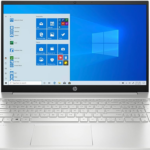If you’re working on machine learning projects the processing and GPU requirement is extremely high, while maintaining the tight system temperature. To simplify, we’ve handpicked some high-performance laptops for machine learning that offers ast processors, ample memory, and quick storage empower your computational capabilities.
If you work as a machine learning practitioner, you’ll need a laptop that can keep up with the demands of your job. Laptops for machine learning should have a fast processor, plenty of memory, and quick storage. For your machine learning projects, this article highlights some of the best laptops for machine learning projects.

You’ve come to the right spot if you’re searching for some of the best laptops available for deep learning and machine learning applications. Purchasing a laptop that meets minimal standards and makes work easier is imperative. These needs are as follows:
Minimum Intel® Core i7 Processors of the 7th Generation
- 16 GB RAM
- A 512GB hard drive
- at least 256 gigabytes of storage
- FHD, or high-definition, display
Now let’s examine the finest laptops for work using machine learning.
Best Laptops for Machine Learning- 2024
Macbook M1 Pro
The M1 Pro features a system-on-a-chip (SoC) architecture. It is the first time that professional systems have SoC architecture. The M1 Pro supports up to 200GB/s of memory bandwidth and up to 32GB of unified memory. M1 Pro includes a GPU with up to 16 cores, making it twice as fast as M1. It is approximately 7 times quicker than the integrated graphics on the most recent 8-core PC laptop CPU. This implies that complex operations and huge workloads are handled without issue.

| Feature | Specifications |
| CPU | 10-core CPU with eight performance cores and two efficiency cores; 16-core GPU; 16-core Neural Engine; 200Gbps memory bandwidth |
| GPU | 16-core GPU; 16-core Neural Engine; 200GB/s memory bandwidth |
| Storage | 512GB SSD Configurable to 1TB, 2TB, 4TB, or 8TB |
| RAM | 16GB unified memory, configurable to 32GB |
| Display | 14.2-inch (diagonal) Liquid Retina XDR display; 3024×1964 native resolution at 254 pixels per inch XDR (Extreme Dynamic Range) |
| Cost | Rs. 194,900 onwards |
The new computer also has two USB-C connections that enable USB 4 and Thunderbolt 4, allowing it to play the 6K Pro Display XDR at full quality. 33.7 billion Transistors are integrated inside the M1 Pro.
| Pros | Cons |
| Fast unified memory | High dev cost due for its unique hardware |
| Industry-leading performance per watt | Old design |
| Incredible power efficiency | Only two Thunderbolt ports |
| Enhanced media engines with dedicated ProRes accelerators specifically for pro video processing | Expensive |
| Lightweight |
Macbook M1 Max
M1 Max offers up to 400GB of memory bandwidth, which is double that of M1 Pro and almost six times that of M1. The M1 Max supports up to 64GB of unified memory.

Apple describes it as “the world’s fastest compact professional laptop to perform any type of task.” And it’s hardly unexpected, given that it not only has one of the quickest processing engines ever seen. It’s also added a “studio-quality” microphone array and improved the webcam with image signal processor enhancements.
| Feature | Specifications |
| CPU | 10-core CPU with eight performance cores and two efficiency cores; 32-core GPU; 16-core Neural Engine; 400Gbps memory bandwidth |
| GPU | 32-core GPU; 16-core Neural Engine; 400Gbps memory bandwidth |
| Storage | 1TB SSD Configurable to 2TB, 4TB, or 8TB |
| RAM | 32GB unified memory Configurable to 64GB |
| Display | 16.2-inch (diagonal) Liquid Retina XDR display;1 3456×2234 native resolution at 254 pixels per inch |
| Cost | Rs. 3,29,900 |
The M1 Max has the same 10-core CPU as the M1 Pro. However, it contains an extra 32-core GPU for up to four times higher graphics performance than the M1. There are 57 billion transistors in it. The M1 Max is Apple’s largest chip to date.
| Pros | Cons |
| Transforms graphics-intensive workflows | Costly |
| Massive 32-core GPU for up to 4x faster graphics performance than M1 | Entry-level laptop doesn’t include fast charging plug |
| GPU delivers performance comparable to a high-end GPU, while consuming up to 40 percent less power | No Face ID |
| Excellent battery performance and higher-bandwidth on-chip fabric | |
| Configured with up to 64GB of fast unified memory |
Tensorbook
Lambda is a young hardware business that has already dominated the market with Tensorbook. The laptop includes Lambda Stack. TensorFlow, Keras, PyTorch, Caffe, Caffe 2, Theano, CUDA, cuDNN, and NVIDIA GPU drivers can all be readily installed using the Lambda Stack.

| Feature | Specifications |
| CPU | 8 cores, 2.20 GHz Intel Core i7-10870H with 16 threads, 5.00 GHz turbo, and 16 MB cache |
| GPU | RTX 3080 Max-Q; 16 GB GDDR6, 6144 CUDA cores, 1245-1710 MHz boost clock |
| Storage | 2 TB |
| RAM | 64 GB of 2666 MHz DDR4 SDRAM |
| Display | 15.6″; 1920×1080 (Full HD), 144 Hz, Matte, 72% NTSC |
| Cost | Rs. 2,48,136 with Ubuntu and Rs. 2,63,175 with pre-installed Windows |
Lambda Stack handles framework upgrades, making it a popular choice among machine learning and deep learning enthusiasts. The laptop contains an 8GB GPU, an 8-core processor, 64GB RAM, and a 2TB hard drive. It is an effective tool for machine learning and deep learning applications.
| Pros | Cons |
| Excellent build quality & Lightweight | Low battery performance |
| Best-in-class storage | Expensive |
| Dual SSD | |
| Compelling laptop for ML/DL tasks |
MSI GS65 Gaming Laptop for Machine Learning
If you need a machine-learning laptop that is both durable and portable, the MSI GS65 Stealth is the one to go. The GS65 Stealth is a 15.6-inch ultraportable notebook. It has a thin bezel gaming display and a premium gold-and-black appearance.

The steel frame gives it a solid appearance. It contains 36 GB of RAM and 512 GB of storage, an 8th generation Intel processor, RTX 2060 and GTX 1660Ti graphics cards, and an 8th generation Intel processor. It boasts a 15.6-inch anti-glare screen with a wide-angle view. A USB 3.1 port, an HDMI port, three USB Type-A connectors, and an Ethernet port are provided for communication.
| Feature | Specifications |
| CPU | Up to 9th Gen. Intel® Core™ i7 Processor |
| GPU | NVIDIA® GeForce® GTX 1660 Ti with 6GB GDDR6 |
| Storage | 512 GB |
| RAM | 36 GB |
| Display | 15.6″ FHD (1920×1080), 144Hz, IPS-Level |
| Cost | Rs. 249,390 |
It is a fashionable laptop that stands out from the crowd. The MSI GS65 was specifically created for machine learning and includes a plethora of useful functions. It has an ultra-slim screen that maximises available area. In terms of specifications, this laptop checks all of the machine learning boxes.
| Pros | Cons |
| Ultra-thin display | Expensive |
| Wide-angle 4K view | The laptop design could have been better |
| Good battery life | Memory not configured to run in dual channel mode out of the box |
| Sleek look |
ASUS ROG Zephyrus S
| Feature | Specifications |
| CPU | 2.2 GHz Intel Core i7-8750H 8th Gen processor |
| GPU | NVIDIA GeForce RTX 2070 with Max-Q Design |
| Storage | 1TB |
| RAM | 16GB DDR4 RAM |
| Display | 15.6-Inch FHD (1920×1080) Anti Glare IPS-level panel, 144Hz Refresh Rate, 3ms Response Time, 178 degree Viewing Angle, Panton Validated |
| Cost | Rs. 239,990 |
The ASUS ROG Zephyrus S GX531GX gaming laptop is a popular ultra-slim gaming laptop. Because of its powerful GPU components, it is one of the most efficient laptops for machine learning projects.

This high-performance Asus laptop is one of the best laptops for machine learning. ASUS ROG Zephyrus is well-suited to machine learning and deep learning. It has an 8th generation Intel processor and an NVIDIA RTX 2070 graphics card to allow multitasking. It’s a slim laptop with bright orange highlights. In regular settings, the ASUS ROG Zephyrus offers a 2-hour battery life.
| Pros | Cons |
| Anti Glare screen with wide-angle display | The cost is on the higher side |
| Powerful performance | Gets heated during heavy sessions |
| Useful for both ML and DL | Noisy fans under load |
| Ultra-thin look |
Dell XPS 15 9560
The Dell XPS 15 is an excellent device for both gamers and machine learning developers. It is a powerful laptop with a long battery life. It offers a 15.6-inch screen with 4K resolution and great colour performance for professional design work.
| Feature | Specifications |
| CPU | 7th Generation Intel® Core™ i7-7700HQ Quad-Core Processor (6M cache, up to 3.8 GHz) |
| GPU | NVIDIA® GeForce® GTX 1050 with 4GB GDDR5 and integrated Intel® Iris™ Graphics 640 |
| Storage | Up to 1TB SSD |
| RAM | Up to 32GB 2400MHz DDR4 RAM |
| Display | 15.6″(3840 x 2160) 4K 282ppi IPS LCD glossy |
| Cost | Rs. 304,437 |

It sports a CNC machined aluminium body and a soft-touch paint carbon fibre composite palm rest. The full-size keyboard is a backlit chiclet with a precise touchpad. Because of its modest weight, it is easy to transport. The Dell XPS 15 9560 offers a strong processor, a competent graphics chipset, and a long battery life.
| Pros | Cons |
| Excellent display | Keyboard is not up to the mark |
| Strong performance | Expensive in the segment |
| Robust construction | No webcam |
| Large battery | Heats up |
Razer Blade 15
Razer laptops have always been known for their strength and performance. The business released the most significant improvements in January 2022, the Blade 14, Blade 15, and Blade 17. We’re talking about the Razer Blade 15. The Razer Blade 15 laptop is an improved version with an NVIDIA RTX 3080 Ti GPU if you are willing to spend some money.

| Feature | Specifications |
| CPU | 12th GenerationIntel Core i7-12800H |
| GPU | Nvidia’s RTX 3080 Ti |
| Storage | 1TB PCIe; Extra M.2 PCIe Slot |
| RAM | 16 GB DDR5 4800MHz dual-channel |
| Display | 15.6 inch (1440 x 2560) |
| Cost | Rs. 1,87,925 (May get updated) |
All Razer Blade 15 laptops come with 16 GB of DDR5 RAM and Intel’s 12th Gen CPU, with the exception of the flagship model, which includes an Intel Core i9-12900HK processor. Razer Blade 15 laptops come with three distinct 15-inch displays: FHD 360Hz, QHD 240Hz, and 4K 144Hz.
| Pros | Cons |
| Easy to upgrade | Low battery performance |
| Realistic ray-traced graphics | Gets heated |
| CAN deliver 100 frames per second at 1440p resolution | Loud cooling fan |
| Enhanced response time | No USB-C charging in the base model |
| Great build quality and compact |
Conclusion
If you want to do machine learning and deep learning, I would recommend getting the latest generation CPU, especially an octa-core CPU and GPU. A good GPU boosts overall performance.
I hope this information assisted you in deciding on the finest laptops for machine learning jobs. I’ll be posting a new blog soon about the Best Laptop Configuration for Your Machine Learning Projects.











